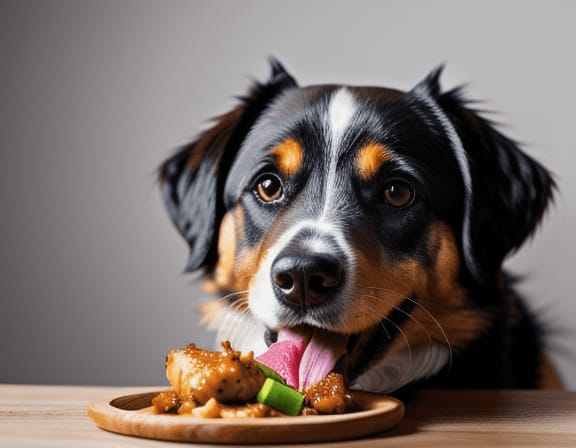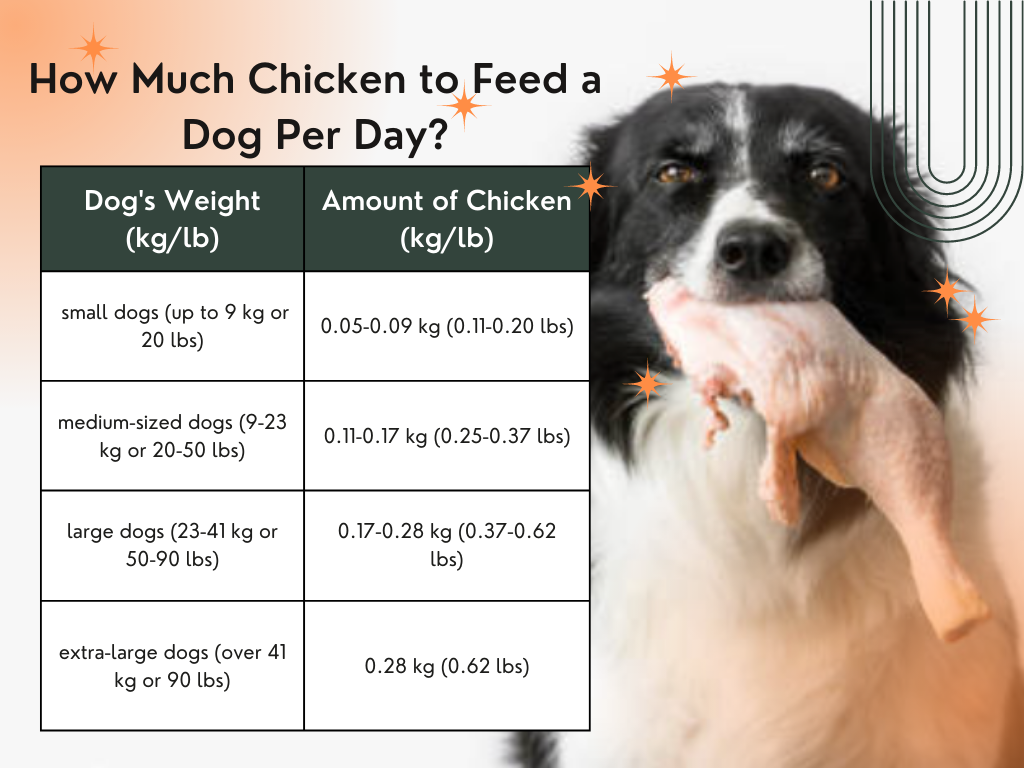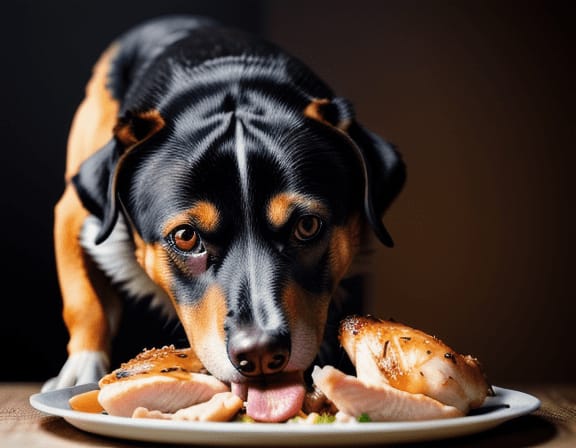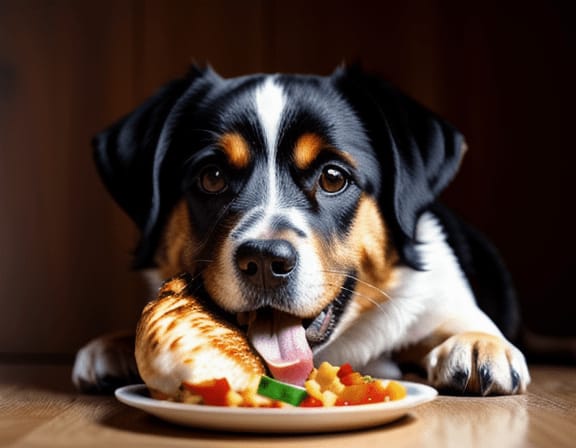As responsible pet owners, we know that providing a well-balanced diet is crucial for the health and happiness of our beloved canine companions.
In this article, we tackle a common question I hear among dog parents: “How much chicken to feed a dog?”
Chicken, a protein-packed meat, is a healthy choice for your dog’s diet, but the right portion size depends on breed, age, weight, and activity level.
We will delve into the science behind calculating the appropriate portion of chicken for your dog’s specific needs and share practical tips, guidelines, and considerations in this 2023 guide.
Wait, there’s more! Stay tuned as we unveil an exclusive bonus—a comprehensive table that provides serving size guidelines based on your dog’s weight! We’ve done the hard work, so you can sit back, relax, and make informed decisions as co-fur parents!
Table of Contents
How Much Chicken to Feed a Dog?

Knowing how much chicken to feed your dog is crucial for maintaining their health and well-being. The right serving size ensures that your furry friend receives the necessary nutrients without overindulging, helping to prevent obesity and other health issues.
Let’s explore the factors that play a role in determining the optimal serving size of chicken for your dog.
Factors for Determining Serving Size
Several factors come into play when determining how much chicken to feed your dog. These factors include weight, age, and activity level. Considering these factors, you can tailor your dog’s chicken portion to meet their needs.
Weight kg/lb (Table)
You may be wondering, “How much chicken for dog by weight kg to feed?” This is an important question since it is crucial to feed your dog the right amount based on their weight to keep their good healthy.
To make it easier for you, we have prepared a helpful table that outlines the recommended serving sizes based on your dog’s weight in kilograms.
This table is a convenient reference, allowing you to accurately determine the ideal amount of chicken to feed your canine companion.

Remember, these are general recommendations, and it’s important to consider other factors, such as the dog’s age, activity level, and overall health. Consulting with your veterinarian will provide personalized advice tailored to your dog’s needs.
Age
Age is another important consideration when determining the serving size of chicken for your dog. Puppies have different nutritional requirements compared to adult dogs. As they grow, their portion sizes will change accordingly.
Activity Level
Active dogs require larger portions to fuel their energy, while less active dogs need smaller portions to avoid weight gain. Consider your dog’s activity level when determining the serving size of a chicken to meet its energy needs.
Considering factors such as weight, age, and activity level helps ensure you feed your dog the right amount of chicken. This promotes their health, satisfaction, and overall thriving.
Can Dogs Eat Chicken Every Day?
Absolutely! Dogs can enjoy chicken every day, but it’s important to determine the right amount. The question on every dog owner’s mind is, “How much cooked chicken to feed a dog daily?”
The ideal portion of cooked chicken for your dog depends on size, weight, age, and activity level. A balanced diet is vital for their nutrient intake. Consult your veterinarian for the perfect serving size, ensuring your pup stays healthy and satisfied.
Dogs love chicken, but it shouldn’t be their sole diet component. A well-rounded meal plan includes proteins, carbs, fats, and vitamins. Combine cooked chicken with other nutritious foods for a balanced diet guided by your veterinarian.
Cooked vs. Boiled Chicken
Consider the cooking method’s impact on feeding your dog. Let’s compare cooked and boiled chicken to help you decide how to effectively serve this tasty treat to your furry friend.
Cooked Chicken:
- It provides a delicious and enticing aroma that dogs love
- Offers essential proteins for your dog’s overall nutrition
- Ensure the cooked chicken is free from harmful seasonings or additives
- The recommended amount of cooked chicken to feed a dog depends on size, weight, age, and activity level
Consult your veterinarian to determine the appropriate serving size based on your dog’s needs.
Boiled Chicken:
- It is a lean and easily digestible option for dogs
- Suitable for dogs with sensitive stomachs or dietary restrictions
- Boiling chicken helps retain its natural flavors while removing excess fat
- Avoid seasoning or adding any harmful ingredients; plain boiled chicken is best
- Like cooked chicken, the recommended amount of boiled chicken to feed a dog depends on size, weight, age, and activity level
Discover the perfect balance in your dog’s diet with the delightful cooked and boiled chicken options. Add a dash of joy with a well-rounded meal plan full of essential nutrients.
Consult your veterinarian for portion sizes and watch your furry friend thrive with happiness and health. And don’t forget to incorporate chicken as a high-value treat you can use when training your pup!
Tips for Feeding Chicken to Dogs

Ah, the joy of treating our furry pals to some tasty chicken! But hold your treats for a moment, as we’ve got some essential tips to make this feeding frenzy even better.
From avoiding seasoning snafus to embracing variety and balance, let’s dig into these paw-some tips to ensure your pup’s chicken feast is nothing short of delightful!
Avoiding Seasoning
Picture this: your pup eagerly awaits their chicken, only to find it sprinkled with ingredients that could turn their tummy upside down. Woof, that’s a no-go!
Ditch the onions, garlic, salt, and spices that can cause tummy troubles when serving chicken to dogs. Stick to plain, unseasoned chicken, and watch their tails wag joyfully!
Homemade Dog’s Food Cooking Techniques
Cooking up a homemade feast for your pup? Be the culinary hero by thoroughly cooking the chicken to eliminate pesky bacteria and parasites, and go easy on the oil and fats.
Variety and Balance
Variety is the spice of life, and dogs crave it too! Chicken might be their main squeeze, but remember to jazz up their menu. Add a pop of color with some crunchy carrots or green beans.
Spice things up with healthy grains like brown rice or quinoa. And remember, consulting with your veterinarian is like having a personal chef guiding you to strike the perfect balance for your pup’s nutritional needs. Bon appétit!
Potential Risks and Considerations
As much as we love spoiling our four-legged companions with chicken, we must be aware of potential risks and considerations.
Consider key factors like allergies, sensitivities, and overfeeding risks when feeding chicken to your pup. Prioritize their safety, happiness, and health for a well-informed approach.
Allergies and Sensitivities
Like humans, dogs can develop allergies or sensitivities to certain foods, including chicken. Keep a keen eye on your pup’s reaction after consuming chicken.
If you notice any signs of discomfort, such as:
- Itching
- Digestive upset
- Skin irritations
It’s wise to consult your veterinarian. They can help determine whether your dog has allergies or sensitivities and guide you in making appropriate dietary adjustments.
Overfeeding and Health Risks
Ah, the temptation to spoil our furry pals with endless chicken delights! But hold your barks for a moment. Overfeeding can lead to some potentially severe health issues.
While chicken can be a nutritious addition to their diet, it’s crucial to maintain portion control and balance. Excessive consumption can lead to:
- Weight gain
- Digestive problems
- Nutritional imbalances
Be mindful of your dog’s overall calorie intake, and consult with your veterinarian to determine the appropriate serving sizes.
Conclusion
Remember, being a savvy fur parent means staying informed and making decisions that prioritize your dog’s well-being. So go ahead, and embrace the joy of feeding your dog chicken while keeping their health and happiness in mind.
By understanding the optimal serving size, considering potential risks, and following our tips, you can embark on a culinary adventure that will make your pup’s tail wag with delight!
FAQs
Is it safe for dogs to eat chicken bones?
No, it is unsafe for dogs to consume chicken bones as they can splinter and pose a choking hazard or cause damage to the digestive tract. Stick to boneless chicken when feeding your dog.
Can I give my dog raw chicken?
While some dog owners opt for a raw food diet, it’s essential to consult your veterinarian before feeding your dog raw chicken due to the risk of bacterial contamination such as Salmonella. Proper handling and hygiene are crucial if providing raw chicken.
How often can I include chicken in my dog’s diet?
The frequency of including chicken in your dog’s diet depends on their needs and overall dietary balance. It’s recommended to consult with your veterinarian to determine the appropriate frequency and portion sizes based on your dog’s specific requirements.
How much boiled chicken to feed dog?
A small dog, weighing 10 to 20 pounds, can eat 1/4 to 1/2 cup of boiled chicken per day. A larger dog, weighing 50 to 100 pounds, can eat 1 to 2 cups of boiled chicken per day. Please note that These are estimated measures that can differ based on the dog’s weight, age, and overall health.

